1996 PONTIAC PONTIAC wheel
[x] Cancel search: wheelPage 162 of 370
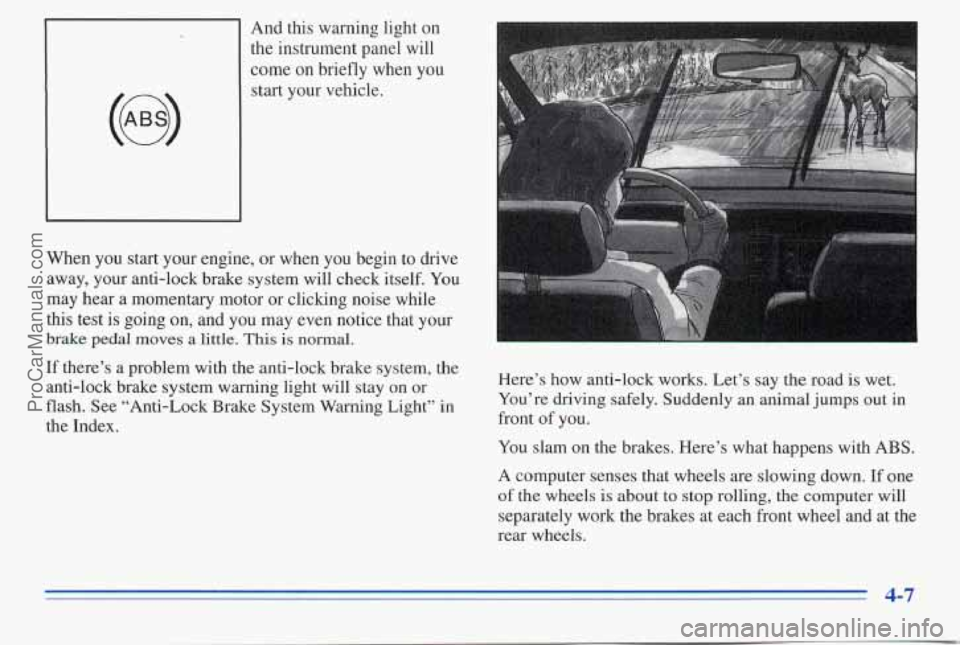
And this warning light on
the instrument panel will
come on briefly when you
start your vehicle.
When you start your engine, or when you begin to drive
away, your anti-lock brake system will check itself. ‘You
may hear a momentary motor or clicking noise while
this test
is going on, and you may even notice that your
brake pedal moves a little. This is normal.
If there’s a problem with the anti-lock brake system, the
anti-lock brake system warning light will stay on or
flash. See “Anti-Lock Brake System Warning Light” in
the Index. Here’s how anti-lock works. Let’s say
the road is wet.
You’re driving safely. Suddenly an animal jumps out in
front of you.
You slam on the brakes. Here’s what happens with
ABS.
A computer senses that wheels are slowing down. If one
of the wheels is about to stop rolling, the computer will
separately work the brakes at each front wheel and at the
rear wheels.
4-7
ProCarManuals.com
Page 163 of 370
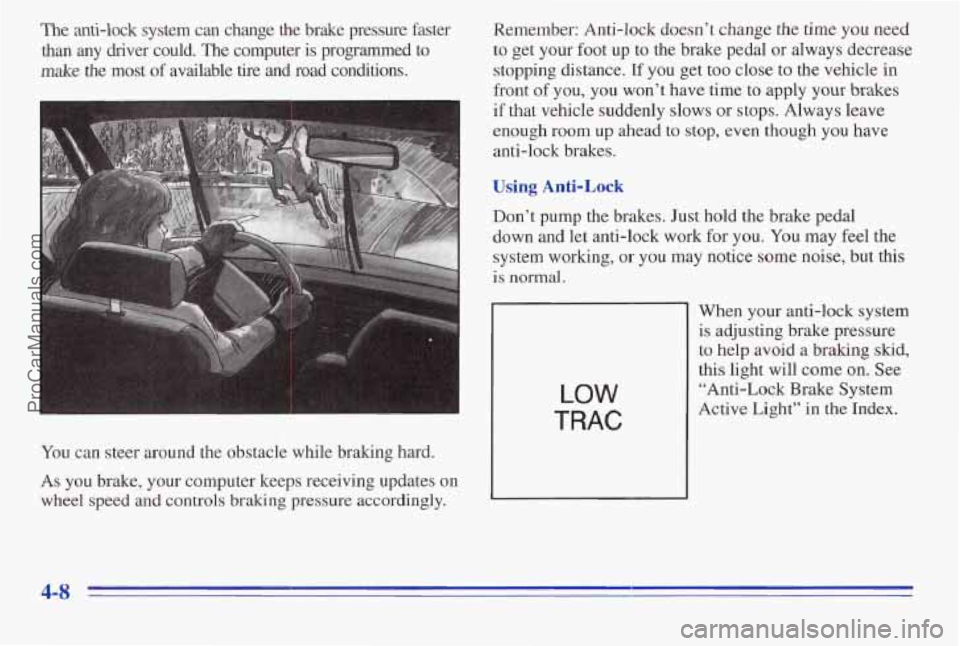
The anti-lock system can change the brake pressure faster
than any driver could. The computer is programmed to
make the most of available tire and road conditions.
You can steer around the obstacle while braking hard.
As you brake, your computer keeps receiving updates on
wheel speed and controls
braking pressure accordingly. Remember: Anti-lock doesn’t
change the time you
need
to get your foot up to the brake pedal or always decrease
stopping distance. If you get too close
to the vehicle in
front
of you, you won’t have time to apply your brakes
if that vehicle suddenly slows or stops. Always leave
enough room up ahead to
stop, even though you have
anti-lock brakes.
Using Anti-Lock
Don’t pump the brakes. Just hold the brake pedal
down and let anti-lock
work for you. You may feel the
system working,
or you may notice some noise, but this
is normal.
LOW
TRAC
When your anti-lock system
is adjusting brake pressure
to help avoid a braking
skid,
this light will come on. See
“Anti-Lock Brake System
Active
Light” in the Index.
4-8
ProCarManuals.com
Page 164 of 370
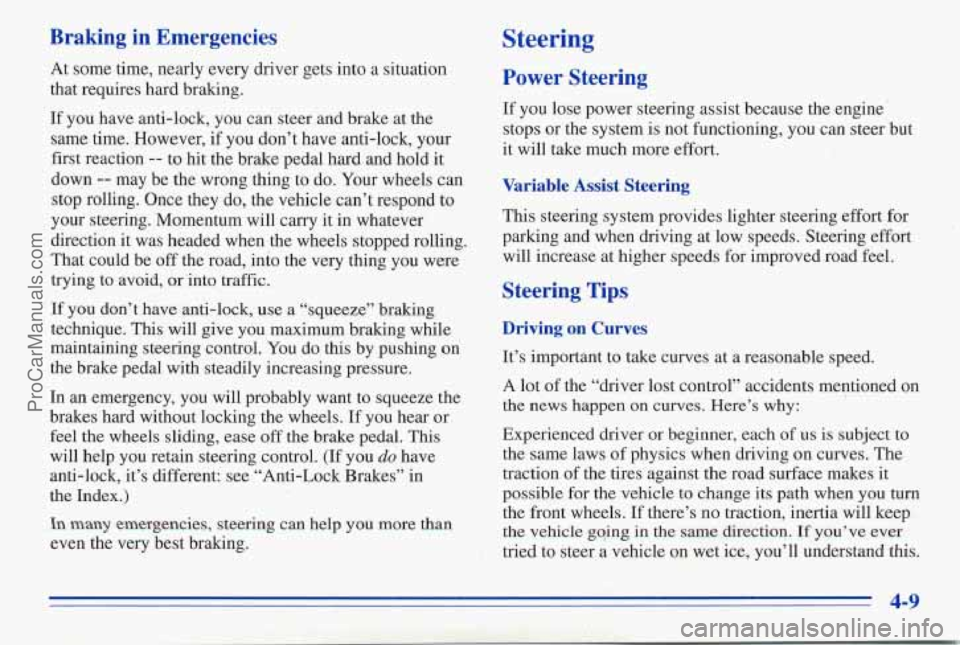
Braking in Emergencies
At some time, nearly every driver gets into a situation
that requires hard braking.
If you have anti-lock, you can steer and brake at the
same time. However,
if you don’t have anti-lock, your
first reaction
-- to hit the brake pedal hard and hold it
down
-- may be the wrong thing to do. Your wheels can
stop rolling. Once they do, the vehicle can’t respond to
your steering. Momentum will
carry it in whatever
direction it was headed when the wheels stopped rolling.
That could be off the road, into the very thing you were
trying to avoid, or into traffic.
If you don’t have anti-lock, use
a “squeeze” braking
technique.
This will give you maximum braking while
maintaining steering control. You do this by pushing on
the brake pedal with steadily increasing pressure.
In an emergency, you will probably want to squeeze the
brakes hard without locking the wheels. If you hear or
feel the wheels sliding, ease
off the brake pedal. This
will help you retain steering control. (If you
do have
anti-lock, it’s different: see “Anti-Lock Brakes” in
the Index.)
In many emergencies, steering can help you more than
even the very best braking.
Steering
Power Steering
If you lose power steering assist because the engine‘
stops or the system is not functioning, you can steer but
it will take much more effort.
Variable Assist Steering
This steering system provides lighter steering effort for
parking and when driving at low speeds. Steering effort
will increase at higher speeds for improved road feel.
Steering Tips
Driving on Curves
It’s important to take curves at a reasonable speed.
A lot of the “driver lost control” accidents mentioned on
the news happen on curves. Here’s why:
Experienced driver or beginner, each of us is subject to
the same laws
of physics when driving on curves. The
traction of the tires against the road surface makes it
possible for the vehicle to change its path when you turn
the front wheels. If there’s no traction, inertia will keep
the vehicle gqing in the same direction. If you’ve ever
. . ,,: ., .. %
A,. .c .. j: tried to steer a vehicle on wet ice, you’ll understand this.
ProCarManuals.com
Page 165 of 370
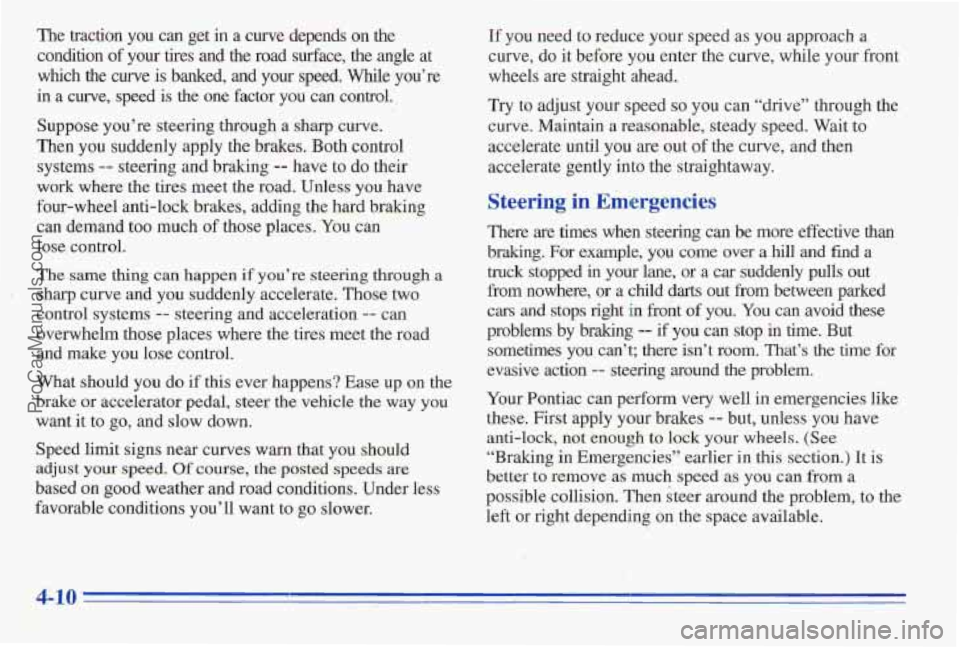
The traction you can get in a curve depends on the
condition of your tires and the road surface, the angle at
which
the curve is banked, and your speed. While you’re
in a curve, speed is the one factor you can control.
Suppose you’re steering through a sharp curve.
Then you suddenly apply the brakes. Both control
systems
-- steering and braking -- have to do ~eir
work where the tires meet
the road. Unless you have
four-wheel anti-lock brakes, adding
the hard braking
can demand too much of those places. You can
lose control.
The same thing can happen if you’re steering through a
sharp curve and you suddenly accelerate. Those two
control systems
-- steering and acceleration -- can
overwhelm
those places where the tires meet the road
and make you lose control.
What should you do
if this ever happens? Ease up on the
brake or accelerator pedal, steer the
vehicle the way you
want it to
go, and slow down.
Speed limit signs near curves warn that you should
adjust your
speed, Of course, the posted speeds are
based on good weather and road conditiolls. Under less
favorable conditions you’ll want to go slower.
If you need to reduce your speed as you approach a
curve, do it b’efore you enter the curve, while your front
wheels are straight ahead.
Try to adjust your speed so you can “drive” through the
curve. Maintain a reasonable, steady speed. Wait to
accelerate until you
are out of the curve, and then
accelerate gently into the straightaway.
Steering in Emergencies
There are times when steering can be more effective than
braking. For example, you come over
a hill and find a
truck stopped
in your lane, or a car suddenly pulls out
from nowhere, or a child darts out from between parked
cars and stops right in front of you. You can avoid these
problem
by braking -- if you can stop in time. But
sometimes you,can’t; there isn’t room. That’s the time for
evasive action
-- steering around the problem.
Your Pontiac can perform very well in emergencies like
these. First apply your brakes
-- but, unless you have
anti-lock, not enough
to lock your wheels. (See
“Braking in Emergencies” earlier in this section.) It
is
better t’o remove as much speed as you can from a
possible collision. Then steer around
the problem, to -the
left ‘or right depending on the space available.
I’ . , .I ,. ’ .~
.. . . ,.- , . . .. .
. .. :.
. . - I 1-.. -’ . ..
ProCarManuals.com
Page 166 of 370
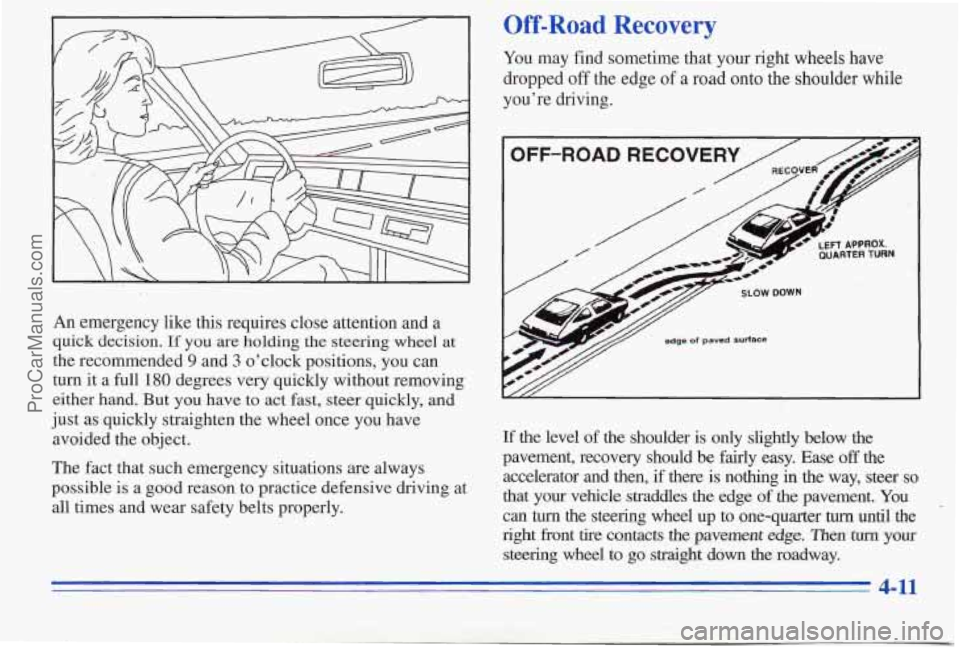
An emergency like this requires close attention and a
quick decision.
If you are holding the steering wheel at
the recommended 9 and 3 o’clock positions, you can
turn it a full
180 degrees very quickly without removing
either hand. But you have to act fast, steer quickly, and
just
as quickly straighten the wheel once you have
avoided the object.
The fact that such emergency situations are always
possible is a good reason to practice defensive driving at
all times and wear safety belts properly.
Off-Road Recovery
You may find sometime that your right wheels have
dropped
off the edge of a road onto the shoulder while
you’re driving.
OFF-ROAD
.
t- - LEFT APPROX. r-
QUARTER TURN
If the level of the shoulder is only slightly below the
pavement, recovery should be fairly easy. Ease off the
accelerator and then, if there is nothing
in the way, steer so
that your vehicle straddles the edge of the pavement. You
can turn the steering wheel up to one-quarter turn until the
right front tire contacts the pavement
edge. TRen turn your
steering wheel to go straight down the roadway.
4-11
ProCarManuals.com
Page 168 of 370
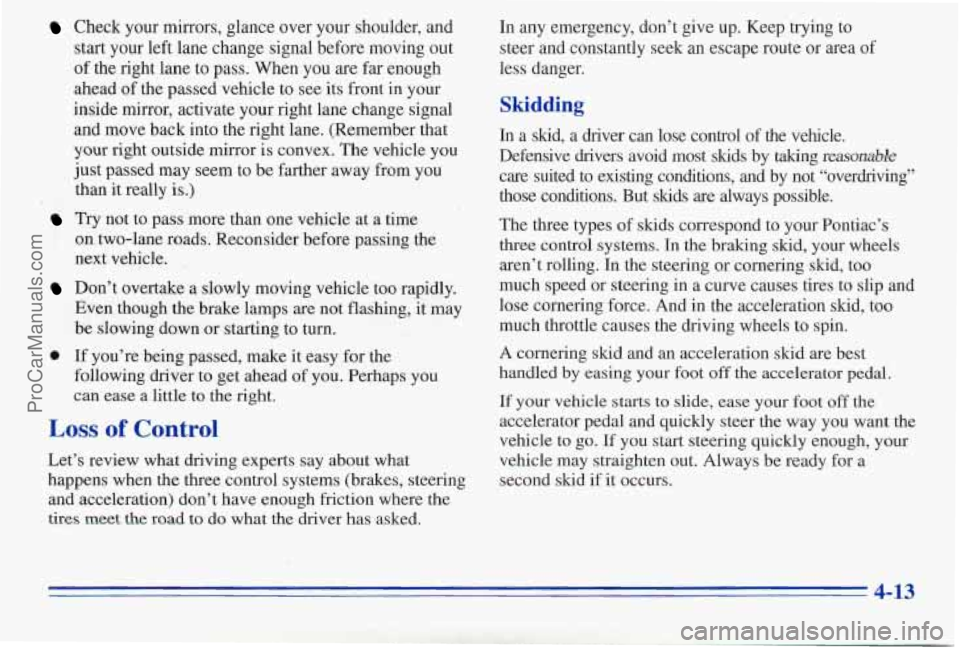
Check your mirrors, glance over your shoulder, and
start your left lane change signal before moving out
of the right lane to pass. When you are far enough
ahead of the passed vehicle to see its front in your
inside mirror, activate your right lane change signal
and move back into the right lane. (Remember that
your right outside mirror
is convex. The vehicle you
just passed may seem to be farther away from you
than it really
is.)
on two-lane roads. Reconsider before passing the
next vehicle.
Don’t overtake a slowly moving vehicle too rapidly.
Even though the brake lamps are not flashing, it may
be slowing down or starting to turn.
Try not to pass more than one vehicle at a time
0 If you’re being passed, make it easy for the
following driver to get ahead of you. Perhaps you
can ease a
little to the right.
Loss of Control
Let’s review what driving experts say about what
happens when the three control systems (brakes, steering
and acceleration) don’t have enough friction where
the
tires meet the road to do what the driver has asked. In
any emergency, don’t give up. Keep trying to
steer and constantly seek an escape route or area
ot
less danger.
Skidding
In a slud, a driver can lose control of the vehcle.
Defensive drivers avoid most skids by
taking reasonable
care suited to existing conditions, and by not “overdriving”\
those conditions. But skids
are always possible.
The three types of skids correspond to your Pontiac’s
three control systems.
In the braking skid, your wheels
aren’t rolling. In the steering or cornering skid, too
much speed or steering in a curve causes tires to slip and
lose cornering force. And in the acceleration skid, too
much throttle causes the driving wheels
to spin.
A cornering skid and an acceleration skid are best
handled by easing your foot
off the accelerator pedal.
If your vehicle starts to slide, ease your foot off the
accelerator pedal and quickly steer the way you want the
vehicle to go.
If you start steering quickly enough, your
vehicle may straighten out. Always be ready for a
second skid if it occurs.
ProCarManuals.com
Page 169 of 370

Of course, traction is reduced when water, snow, ice,
gravel or other material is on the road. For safety,
you’ll
want to slow down and adjust your driving to these
conditions. It is important to slow down on slippery
surfaces because stopping distance will be longer and
vehicle control more limited.
While driving on
a surface with reduced traction, try
your best to avoid sudden steering, acceleration or
braking (including engine braking by shifting to a lower
gear). Any sudden changes could cause the tires to slide.
You may not realize the surface is slippery until your
vehicle is skidding. Learn to recognize warning
clues -- such as enough water, ice or packed snow MI
the road to make a “mirrored surface” -- and slow down
when you have any doubt.
If you have the anti-lock braking system, remember: It
helps avoid
only the braking skid. If you do not have
antblock, then
in a braking skid (where the wheels are
Driving at Night
no longer rolling), release enough pressure on the brakes
to get the wheels rolling again. This restores steering
control. Push the hake pedal
down steadily when you
have to
stop suddenly. As long as the wheels are rolling, Night
driving is more dangerous than day driving. One
reason is
that some drivers are likely to be impaired -- by
alcohol QT drugs, with night vision problems, or by fatigue.
you
will have steering control.
4-14
~.
ProCarManuals.com
Page 177 of 370
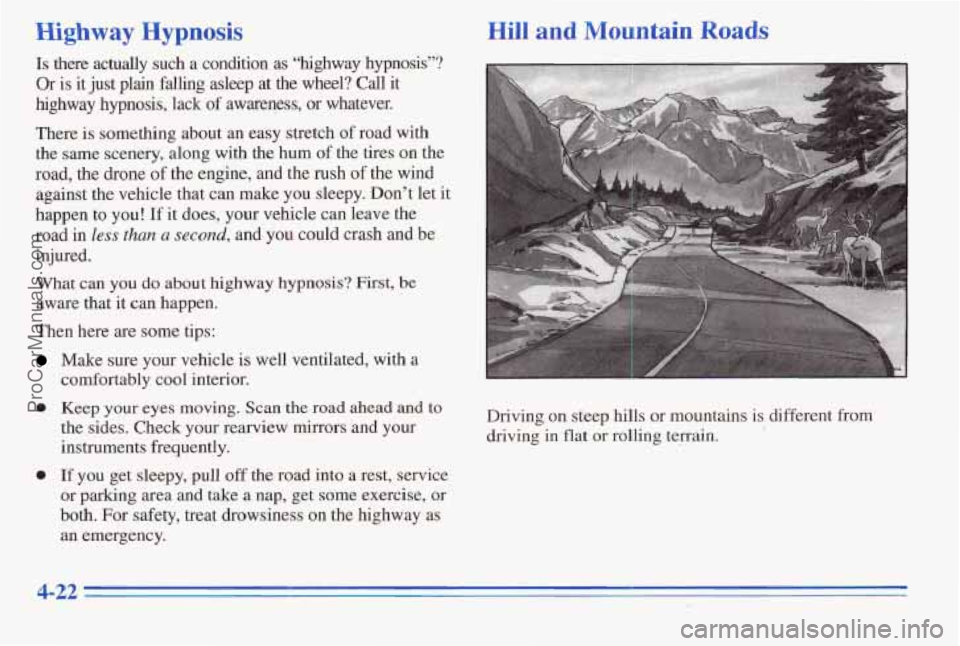
Highway Hypnosis Hill and Mountain Roads
Is there actually such a condition as “highway hypnosis”?
Or
is it just @.am falg asleep at the wheel? Call it
highway.hypnosis, lack of awaeqess,
Q]: whatever.
There
is something about an easy stretch of road with
the same scenery,
along with the hum of the tires on the
.road,
the &one of the &&e, and the rush of the wind
against the vehicle that can make you sleepy. Don’t let it
happen to you!
If it does, your vehicle can leave the
road in less than a second, and you could crash and be
injured.
What can you do about highway hypnosis? First, bt
aware that it can happen.
Then here are
some tips:
Make sure your vehicle is well ventilated, with a
comfortably cool interior.
e Keep your eyes moving. Scan the road ahead ad to
the sides. Check your rearview minors and your
instruments frequently.
a If you get sleepy, pull off the mad into a rest, service
or
parking area and take a nap, get some exercise, or
both. For safety, treat drowsiness on the hghway as
an emergency. Driving
on steep hills or
mountains is different from
driving in flat or rolling terrain. I
ProCarManuals.com